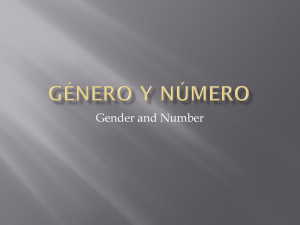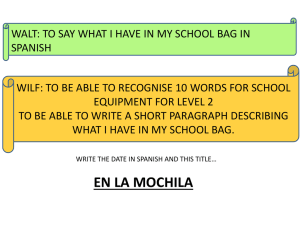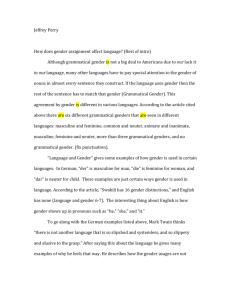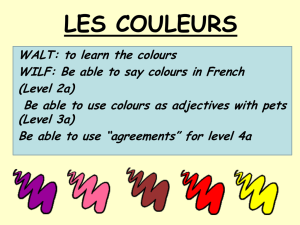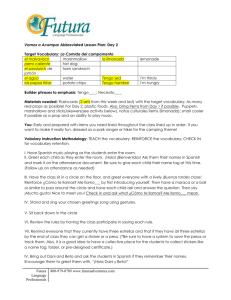Week 5 Lesson 2
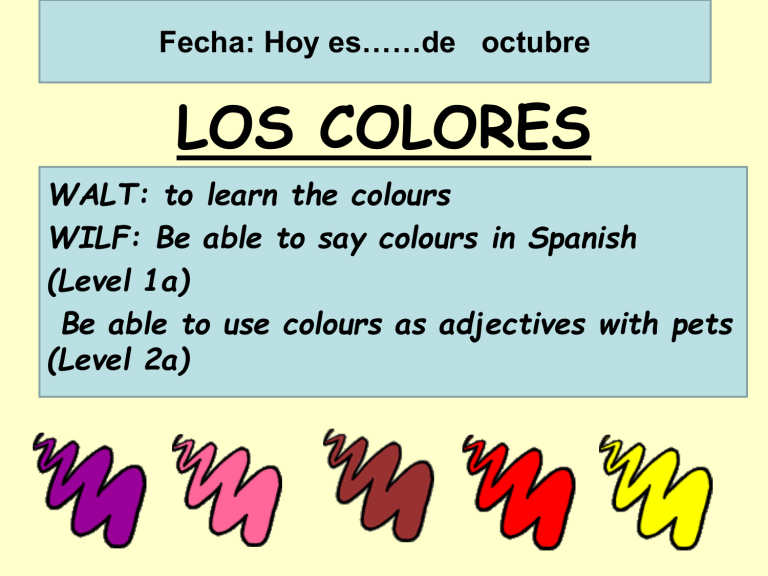
Fecha: Hoy es ……de octubre
LOS COLORES
WALT: to learn the colours
WILF: Be able to say colours in Spanish
(Level 1a)
Be able to use colours as adjectives with pets
(Level 2a)
COPY THE WORDS FOR COLOURS IN SPANISH AND ENGLISH INTO YOUR BOOK blanco amarillo negro rojo violeta rosa marrón verde naranja gris azul
ADJECTIVES (A describing word)
• COLOURS ARE ADJECTIVES AND ARE
WRITTEN AFTER THE NOUN (THE
PERSON, PLACE OR THING)
• Example: UN PERRO MARRON
“MARRON” COMES AFTER “PERRO”
SO IN SPANISH, YOU ARE ACTUALLY
SAYING “A DOG BROWN”.
LOOK AT THE FOLLOWING EXAMPLES AND COPY THEM INTO
YOUR BOOK IN SPANISH AND ENGLISH….
THE FIRST ONE HAS BEEN DONE IN ENGLISH TO HELP YOU. YOU
CAN WORK OUT THE REST ON YOUR OWN!
TENGO ... (I have...)
Un perro blanco = a white dog
TENGO ...
Un gato negro
Tengo ...
Un perro marrón
Tengo ...
un gato gris
Tengo ...
un pez naranja
Tengo...
un conejo blanco
Tengo ...
un conejo gris
Tengo ...
un caballo marrón
Tengo ...
un pájaro verde
Did you notice anything different about the Spanish word for “a” with pets from last lesson? Some of you may already have read this already.
Un gato
= A cat
Una araña
= A spider
That’s right, one says “un”, the other says “una”.
They both mean “a” so why are they different?
In Spanish all nouns (person, place or things) are known as either Masculine or
Feminine .
Read the next slide carefully as it will explain more keywords
READ THIS SLIDE VERY CAREFULLY
Every NOUN in Spanish is either Masculine or
Feminine
A noun is a person, place or thing. Any word that you can put the word “a” or “the” in front.
In Spanish, the words for “a” and “the” are different, depending on if the word is masculine or feminine .
ENGLISH
A
MASCULINE
UN
FEMININE
UNA
LA
THE EL
REMEMBER: It is the “word” itself which is either masculine or feminine. You might own a female cat, but the word for “cat” in Spanish will always be masculine.
How do you know if a word is masculine or feminine? You have to learn them!!
When you learn a new noun in Spanish, you will always learn it with the extra words “UN”, “UNA”, “EL” or “LA”. Just like you did with the words for pets.
IT IS IMPORTANT TO KNOW IF THE NOUN IS MASCULINE OR FEMININE.
IF THE NOUN IS FEMININE, IT HAS AN EFFECT ON THE ADJECTIVE.
LOOK…
UNA TORTUGA LENTA
= A SLOW TURTLE
BECAUSE THE WORD FOR TURTLE IN
SPANISH IS “FEMININE”, YOU MUST ADD
AN “A” TO THE ADJECTIVE
THERE ARE SOME OTHER RULES TO
BE AWARE OF…
IF THE COLOUR ALREADY ENDS IN
AN “E” YOU DO NOT NEED TO ADD
ANOTHER.
THERE ARE ALSO SOME COLOURS
WHICH ARE SLIGHTLY DIFFERENT
WITH “FEMININE” NOUNS. THE TABLE
ON THE NEXT SLIDE WILL HELP YOU.
MASCULINE
BLANCO
NEGRO
ROJO
AMARILLO
VERDE
NARANJA
VIOLETA
GRIS
MARRÓN
FEMININE
BLANCA
NEGRA
ROJA
AMARILLA
VERDE
NARANJA
VIOLETA
GRIS
MARRÓN
ADD “A”
ALREADY
HAS AN “E”
DO NOT
CHANGE”
SOME MORE EXAMPLES..
UNA ARAÑA VERDE
UN RATÓN VIOLETA
SOME ANIMALS CAN BE MORE THAN ONE COLOUR. HERE IS WHAT
YOU DO IN SPANISH…
UNA SERPIENTE NEGRA, ROJA, AMARILLA Y
VIOLETA
EXERCISE 1. COPY EACH PHRASE INTO YOUR BOOK BY COMPLETING IT
WITH THE CORRECT COLOUR. THINK ABOUT IF THE COLOUR NEEDS AN
EXTRA “A” OR NOT.
un gato.....
un conejo de indias.....
Un ratón.....
un pájaro.....
una serpiente.....
un caballo.....
un perro.....
un pájaro.....
un pez.... y.....
un conejo.....
un loro...............
Una tortuga......
EXERCISE 2: MAKE YOUR OWN POWERPOINT PRESENTATION TO
DEMONSTRATE WHAT YOU HAVE LEARNED TODAY. FIND PICTURES
OF PETS ON GOOGLE AND WRITE A DESCRIPTION IN SPANISH. AIM
FOR 5 SENTENCES CORRECT FOR A LEVEL 2A.
LOOK AT THIS EXAMPLE….
TENGO UN PEZ NARANJA
